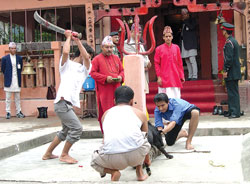|
|
We celebrate Dasain by appeasing the goddess Kali so that she will chase away the demons and bring us health, wealth and victory. After all, this is a festival of the triumph of good over evil.
This is also the festival of blood-letting as thousands upon thousands of goats, sheep, buffaloes, chickens and ducks are cruelly slaughtered on our streets and temples. Our idols are made of stone, but they drip with the blood of our fellow beings.
It is now time to think about what this means in a festival that celebrates the victory of good. Why are we exhibiting such cruelty, and how does this reflect on our society? If we are indeed human beings, why can't we learn to be a little more humane during a national festival? A society that treats animals so brutally will also be brutal towards fellow humans.
It could be that our martial ancestors, while unifying the country and fighting invaders, had to harden their hearts. It may be a part of our tradition that the khukuri wielded in the battlefields first had to draw the blood of sacrificial animals. During the Malvinas war, the British Army used the Gurkhali reputation for fierceness with the khukuri to defeat the Argentinians.
Our enemies today are not demons. It is superstition, fatalism, poverty and social inequity that plagues our society. We will defeat and overcome these ills by being more humane and caring ourselves, by showing civilized behaviour. Decapitating a bleating buffalo or goat should not be the symbol of the Nepali civilisation.
Rage is a human trait. Rage leads to cruelty. But it is not a human attribute to enjoy brutality. Yet, in Mugu 32 years ago I witnessed the most cruel custom of rubbing chillies and salt on a goat's skin. The spectators cheered as the goats writhed and leapt in agony, and finally they bit the goat's skin until its entrails spilled out. There was a loud cheer as the goat was then dragged off to be killed at the temple. While watching this spectacle in horror, I asked myself are these human beings or are they hyenas? What kind of people take pleasure in such cruelty?
In Khokana of Lalitpur there is a similar sacrifice ritual in which a goat is thrown into a pond while participants jump in to tear the animal apart with their bare hands and teeth. In Bhaktapur pigs are skinned alive and their chests opened, and the living heart yanked out. The screaming mercifully dies, while its still-beating heart is offered to the temple amidst loud music.
At Dasain, buffaloes are slaughtered by their hundreds in Nepal's momo capital of Kathmandu. The sidewalks and gutters of Kot run red with buffalo blood. Even Hindus from other countries are shocked by the bloodletting in Nepal.
For the buffaloes, when the end comes, it is a relief. They have been tortured by the transportation from India and the tarai towns to Kathmandu packed in livestock trucks. They are tethered with ropes that go through their nostrils, they foam at the mouth, and I have seen them actually shed tears of pain from their deep blue eyes. Their skins is lacerated by friction against the sides of the truck.
To eat meat we have to kill animals. But why do we have to inflict such pain before we do so? This is not just inhuman, it is also against the law in many countries. Animals, be they beasts of burden, pets, dairy animals or livestock for meat have to be treated humanely. Nepal also now needs to enact such laws.
It is morally wrong to torture fellow creatures, but to do so in the name of religion is a sin. The government should set an example by stopping official sacrifices.
Temples should follow by banning cruel slaughter on their premises. By sacrificing animals in front of cars, trucks, buses, even aircraft, we are promoting a culture of violence.
Let us set a precedence for non-violence by stopping cruel animal sacrifices and slaughter in the New Nepal.
Tirtha Bahadur Shrestha, PhD, is a noted botanist and this year's winner of the Jagadamba Shri Award for using literature to popularise science in Nepal.




